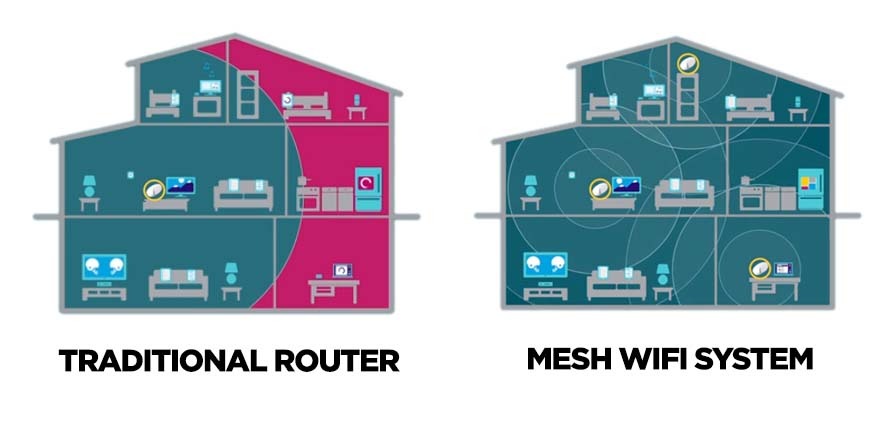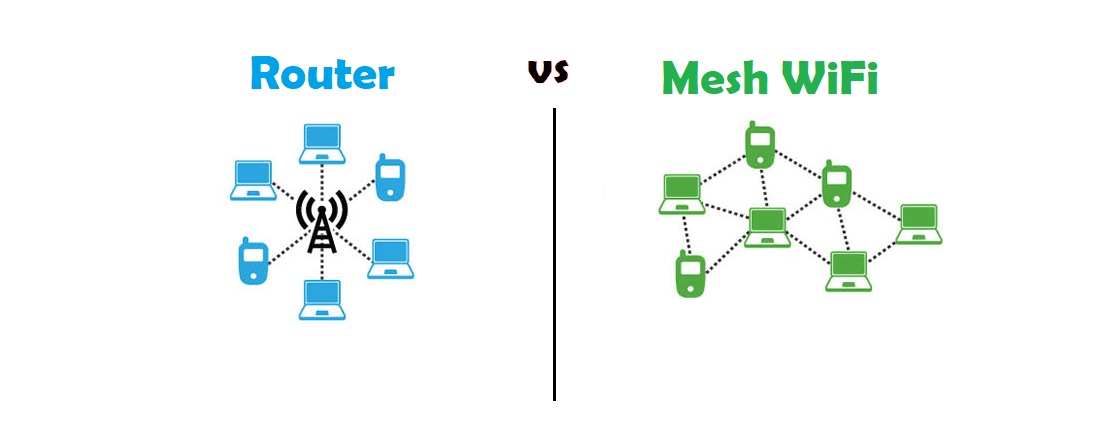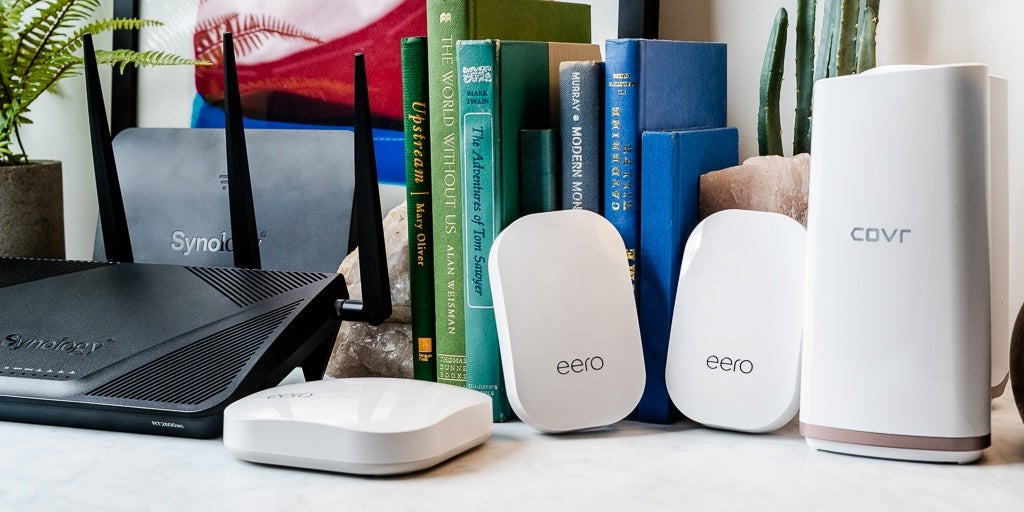What Is Mesh WiFi?
First and foremost, let’s understand in laymen’s terms what exactly a Mesh WiFi setup is. Take your traditional WiFi router that you have installed at home or at your work place. Consider this particular router on its own (i.e. do not consider any extenders, boosters, other signal enhancers). The way this WiFi router works is by allowing your device to connect to it and then granting you internet access through your internet service provider outback. Your WiFi router has a particular range and the further you move out of this range, the more your connection’s quality degrades. This is because you have this sole access point (your router) to connect to in order to get access to the internet. Now, let’s consider an extender or booster that you may have installed at home or at work. When you have a large area to provide with WiFi, it is common to install multiple such routers or access points that boost the signal of the original main WiFi router. If you have an access point in each room, for example, the people of that room can use that access point to connect and get strong wireless reception. Through this entire situation, one thing we can takeaway is that your connection signal strength is dependent upon how close or far away you are from your router and going out of range will cause you to disconnect or slow down your internet’s speed. Multiple access points give you more points closer to where you are to connect to, thereby boosting your connectivity signal quality. This is the principle Mesh WiFi routers capitalize on. Mesh WiFi routers have one central primary router that you install in your home (or work place) and that central primary router is wired to multiple nodes which behave as satellite access points. Because these are not separate routers or extenders, they behave as one seamless router along with your primary unit. They operate as a single entity. Your WiFi signal is propagated throughout the area that you have spread your satellite nodes out across and wherever you go, the node closest to you (the one providing the strongest connection signal) is the one that will interact with your device. You will be free from the hassle of disconnecting from one router and connecting to the next one as you enter a different room. Your connection speed will remain fairly constant as you seamlessly ping off of one node and then the next depending upon where you are. In addition to the seamless connectivity from node to node, another positive of this setup is that it is freely scalable. The size of your home or building does not matter. You can simply add more nodes of the same central primary routers to extend its connectivity and give you more satellite points to connect to. This concept ensures that there is no area in your home or at work that has poor WiFi connectivity. If it does, simply add a node there.
What Distinguishes Mesh WiFi Routers From Traditional Ones?
As explained earlier, the primary monumental difference between a Mesh WiFi router and a traditional WiFi router is the fact that the Mesh setup is seamless while the traditional one is not. The Mesh system has one centralized access point that is extended to various corners of the area it is intended to span across through satellite node. These nodes create a space of all-encompassing connectivity, encircling the area they cover. Traditional WiFi routers, on the other hand, have one router as an access point and require extenders or boosters (which are separate routers essentially) to boost the signal. This setup is not seamless and is just a conjunction of numerous primary routers as opposed to one primary router in the Mesh WiFi network and multiple seamless satellite nodes coming out of it. Besides this, the WiFi type and connection you are actually using will determine the resident internet speed. That is entirely dependent on your internet service provider but what a Mesh WiFi router will do for you that a traditional router won’t bring the access point closer to you through the multiple nodes it has scattered across the area so that your speed and connectivity are not hindered as a result of distance from the main access point. In a traditional setup, you will have to connect to the extender that is nearest to you and that will be your new access point router. Due to the web-like reach of the satellite nodes, you can scatter numerous of them in a single area. For example, you can have four nodes in each of the four corners of the rooms in a spacious office building. However, if you were to use an extender setup, you would, at most, have one extender per room if needed. You may just choose to have one extender per floor. It is not feasible or practical to have multiple router access points in a single area. The perk of a nodular mesh network setup is that you can scatter several nodes across an area because they are not fundamentally independent identities like routers. They are extensions of the same primary central router and communicate with it seamlessly through wired pathways.
Final Thoughts
As explained throughout this article, the Mesh Wifi network is fundamentally different from the traditional router setup due to its nodular connections that allow for satellite access points scattered across an area. Through the comparison, we know that the two setups work in two different ways. That begs the question, however, which WiFi system setup is better. Due to their different means of operation, ideally, a Mesh WiFi router system would seem more effective. In theory, you are able to connect to different nodes based on where you are located to get the effect of being close to the main access point router. However, the benefit you reap from this setup will be heavily dependent on where you have installed it. If you live in a single-story studio apartment then installing a Mesh WiFi network will not show you any significant or notable improvement in connectivity or internet performance. However, if you live in a multi-story home or are looking to install the setup in a school or office workplace, then the Mesh WiFi router surely trumps the traditional router plus extender or booster setups.
How To Set Up Your Mesh WiFi NetworkXiaomi Announces the Budget Redmi Router AX5 with Wi-Fi 6 and Mesh Networking…Mesh WiFi Routers Purchasing GuideMicrosoft Attempting To Optimize ‘Project Union’ That Ties Traditional Win32…


